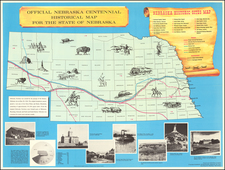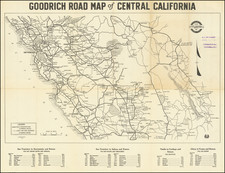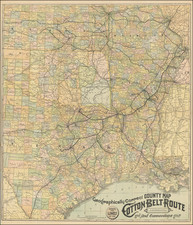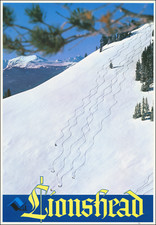Brue's Monumental Wall Map of Texas, Upper California & Mexico
Nice example of Brue's wall map of Texas, Upper California and Mexico, one of the most interesting large format maps of the region published during the period.
Brue's wall map is a tour de force for the Transmississippi West, coming on the eve of the Mexican War, California Gold Rush and the period of intensive American exploration in the west. Wheat described Brue's work as monumental, much on the order of the Arrowsmith and Wyld maps of the period. First issued in 1834, the map was revised in 1837, 1839, 1840, 1845 and 1848, keeping abreast of the changing landscape of the region and the political intrigues of the United States, England, France, Russia and of course Mexico.
The map contains one of the earliest obtainable depictions of the route of Jedidiah Smith. The Route de Smith in 1826 connects Lac Teguayo, to the R. Adams, Rock Salt Cavern and Seeds-Keeder River and San Diego and then extends north to M. St. Joseph. The information was derived from a letter from Smith published in the Nouvelles Annales des Voyages in 1828. Wheat notes that the Brue's attempt to actually depict Smith' route without Smith's map was a shot in the dark, but nevertheless makes Brue's map "one of the foundation stones of western mapping history…."
The unique element of this edition of the map which is of tremendous interest is the identification of the Russian possessions, shown in blue above California (Etabt. Russe). This addition was probably made after a review of the map of Duflot Du Mofras in 1844, and quickly disappears from the map, as it is not included on the 1848 edition.
The map is of nearly equal importance for its treatment of Texas, naming Austin and showing nearly a dozen roads and many other pre-republic details. The mythical river connecting Lac Timpanogos and the Pacific, via the Multnomah River is shown, as are the remnants of the mythical Rio Sacramento, extending from Salt Lake to the Pacific. The treatment of the entirety of the southern Transmississippi West is of great note and marks a milestone at the beginning of the exploration of Texas, the Rockies, California and the Southwest.
In California, two massive lakes are noted east of the Coastal Range on the Tulares River, with a very tentative depiction of the Sierra Nevada Mountains given.
Etienne Prevost Discovery of the Great Salt Lake?
The map also notes a fur trading depot at the Great Salt Lake. The reference to Depot of the Fur Company on the east side of the Great Salt Lake is likely a reference to the Fur Trading activity in the area of the Great Salt Lake, and possibly the of activity of Etienne Provost, a French fur trader operating out of Santa Fe. In 1824, Provost arrived in the vicinity of the Wasatch Front and may have reached the Salt Lake Valley (meaning an arrival before Jim Bridger). Provost's party was driven away by Snake Indians in the fall of 1824 and most of his party were killed. The survivors wintered at the mouth of the White River,, possibly on the Provo, Jordan, or Weber rivers, leading the possibility that Provost discovered the Great Salt Lake that fall, before Bridger. In 1825, Provost made 2 recorded trips to the Wasatch Front from the Green River country, traveling to the Great Salt Lake by way of Weber Canyon.
Warren A. Ferris's 1836 travel narrative and Map of the Northwest Fur Country supports the possibility that Prevost was attacked in 1824 on the Jordan River. Ferris stated that the attack occurred on "a stream flowing into the Big Lake that now bears his name," which would suggest the "Provo" River. This observation, combined with Provost's apparent familiarity with the route through Weber Canyon to the Great Salt Lake, lends credence to the prospect that Prevost reached the Great Salt Lake in the fall of 1824, well before Jim Bridger.
Benjamin Louis Eulalie de Bonneville
In Utah, the "Gd. Lac Sale, Lac Youta, Timpanogos ou Bonneville" (Salt Lake, Utah Lake, Timanogos or Bonneville), reveals the transitional moment between the earlier mythical lake Timpanogos and the Great Salt Lake, and the early reports coming from the Jacob Astor financed 1832 expedition led by Benjamin Louis Eulalie de Bonneville, which resulted in a number of important discoveries between 1832 an 1834. Bonneville left Missouri with 110 men, including lieutenants Michael Cerre and Joseph Walker. The expedition proceeded from Fort Osage on the Missouri River, up to the Platte River, and across present-day Wyoming, reaching the Green River in August, 1832 and constructing a fur trading post, which was alternatively called Fort Bonneville and "Fort Nonsense". In the spring of 1833, Bonneville followed the Snake River to the head of the Salmon River and Fort Nez Perce. This portion of the journey was assisted by John Enos, a 10-year-old Shoshone, who would later serve scout for John Fremont.
Bonneville dispatched Joe Walker to explore the Great Salt Lake and to find an overland route to California. Walker discovered a route along the Humboldt River across present-day Nevada, as well as Walker Pass across the Sierra Nevada. The path later became known as the California Trail, the primary route for the immigrants to the gold fields during the California Gold Rush.
In the summer of 1833, Bonneville traveled to the Wind River Range to trade with the Shoshone and requested additional time from his commanding officer, General Macomb, in part to survey the Columbia River and parts of the Southwest before his return. in January 1834, Bonneville set out for the Willamette Valley in Oregon, proceeding via the Snake River, through Hells Canyon, and into the Wallowa Mountains. On March 4, 1834, they reached Fort Nez Perces, the outpost of the Hudson's Bay Company at the confluence of the Walla Walla River with the Columbia. In July 1834, Bonneville returned to Fort Nez Perces, but was again unable to trade. The group next journeyed down the Columbia towards Fort Vancouver, wintering with the Shoshone along the upper Bear River, before starting back toward the Missouri in April 1835, where he discovered that Macomb had never received his letter requesting additional time to survey and learning that his commission had been revoked.
Andre Hubert Brué was a French geographer and cartographer. Born in Paris, he served in the French Navy, joining the Baudin expedition to the Pacific (1800-1804). After his sea service, Brué applied his navigation and charting skills to creating finely-crafted maps, which were renowned for their crisp engraving and accuracy. He drew directly on the copper of the plate, creating what he called encyprotypes. He is best known for the Atlas universal de géographie physique, politique, ancienne et moderne.

![Nouvelle Carte Du Mexique, Du Texas Et D'Une Partie Des Etats Limitrophes . . . 1840 [Proposed Railroads In Texas -- First Appearance of Arizona on a Printed Map] By Adrien-Hubert Brué](https://storage.googleapis.com/raremaps/img/small/103480.jpg)








![[Kansas City - Witchita - Tulsa - Enid - Springfield] Kansas River (360) World Aeronautical Chart](https://storage.googleapis.com/raremaps/img/small/96224.jpg)



![[ Huntington Beach Infrastructure Map -- Newport Beach to Long Beach ]](https://storage.googleapis.com/raremaps/img/small/98369.jpg)
